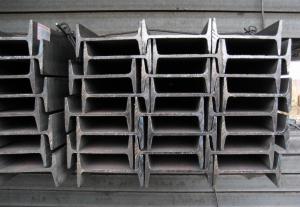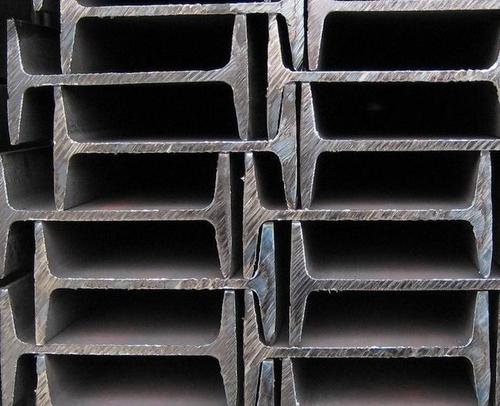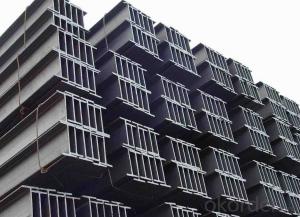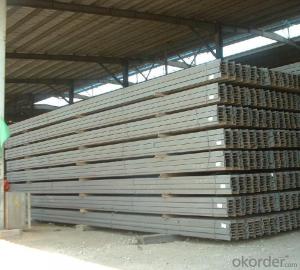IPE-Beams from Size 80-200 with Material Grade Q235
- Loading Port:
- Tianjin
- Payment Terms:
- TT OR LC
- Min Order Qty:
- 25 m.t.
- Supply Capability:
- 10000 m.t./month
OKorder Service Pledge
OKorder Financial Service
You Might Also Like
Product Description:
OKorder is offering high quality Hot Rolled Steel I-Beams at great prices with worldwide shipping. Our supplier is a world-class manufacturer of steel, with our products utilized the world over. OKorder annually supplies products to European, North American and Asian markets. We provide quotations within 24 hours of receiving an inquiry and guarantee competitive prices.
Product Applications:
1. Supporting members, most commonly in the house raising industry to strengthen timber bears under houses. Transmission line towers, etc
2. Prefabricated structure
3. Medium scale bridges
4. It is widely used in various building structures and engineering structures such as roof beams, bridges, transmission towers, hoisting machinery and transport machinery, ships, industrial furnaces, reaction tower, container frame and warehouse etc.
Product Advantages:
OKorder's Steel I-Beams are durable, strong, and resist corrosion.
Main Product Features:
· Premium quality
· Prompt delivery & seaworthy packing (30 days after receiving deposit)
· Corrosion resistance
· Can be recycled and reused
· Mill test certification
· Professional Service
· Competitive pricing
Product Specifications:
1. Invoicing on theoretical weight or actual weight as customer request
2. Standard: EN10025, GB Standard, ASTM
3. Grade: Q235B, Q345B, SS400, ASTM A36, S235JR, S275JR
4. Length: 5.8M, 6M, 9M, 12M as following table
5. Sizes: 80mm-270mm
Dimensions(mm) | |||||
h | b | s | t | Mass Kg/m | |
IPE80 | 80 | 46 | 3.80 | 5.20 | 6.00 |
IPE100 | 100 | 55 | 4.10 | 5.70 | 8.10 |
IPE120 | 120 | 64 | 4.80 | 6.30 | 10.40 |
IPE140 | 140 | 73 | 4.70 | 6.90 | 12.90 |
IPE160 | 160 | 82 | 5.00 | 7.40 | 15.80 |
IPE180 | 180 | 91 | 5.30 | 8.00 | 18.80 |
IPE200 | 200 | 100 | 5.60 | 8.50 | 22.40 |
IPE220 | 220 | 110 | 5.90 | 9.20 | 26.20 |
IPE240 | 240 | 120 | 6.20 | 9.80 | 30.70 |
IPE270 | 270 | 135 | 6.60 | 10.20 | 36.10 |
FAQ:
Q1: Why buy Materials & Equipment from OKorder.com?
A1: All products offered byOKorder.com are carefully selected from China's most reliable manufacturing enterprises. Through its ISO certifications, OKorder.com adheres to the highest standards and a commitment to supply chain safety and customer satisfaction.
Q2: How do we guarantee the quality of our products?
A2: We have established an advanced quality management system which conducts strict quality tests at every step, from raw materials to the final product. At the same time, we provide extensive follow-up service assurances as required.
Q3: How soon can we receive the product after purchase?
A3: Within three days of placing an order, we will begin production. The specific shipping date is dependent upon international and government factors, but is typically 7 to 10 workdays.
Images:

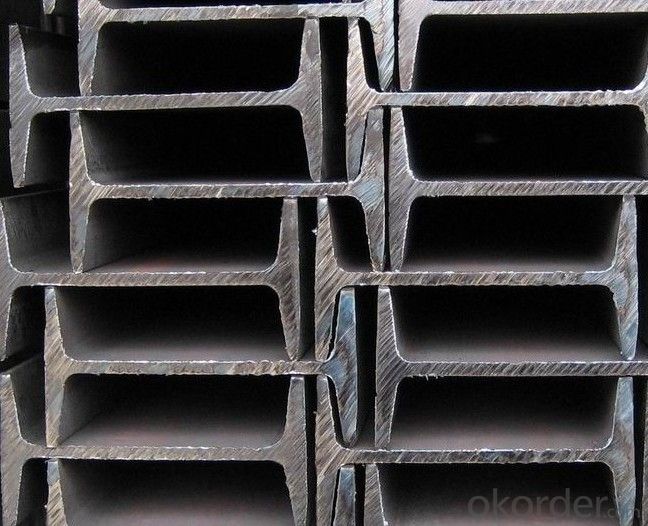
- Q:What are the considerations for steel I-beam design in high-humidity areas?
- To ensure the structural integrity and longevity of steel I-beams in high-humidity areas, several considerations must be taken into account. The choice of materials is crucial, with stainless steel or galvanized steel often being preferred due to their corrosion resistance properties. These materials have a protective layer that prevents rust or corrosion from weakening the beams. Proper ventilation and drainage systems should be incorporated into the design to prevent moisture accumulation. Moisture can accelerate corrosion, so it is important to allow for proper airflow and drainage to keep the beams dry. This can be achieved through weep holes, vents, or the use of protective coatings or insulation. Regular maintenance and inspection are essential to identify and address any signs of corrosion or damage. High-humidity areas pose a greater risk of corrosion, so a maintenance plan including inspections, cleaning, and repairs should be implemented. Environmental factors in high-humidity areas should also be considered. If the area is prone to saltwater exposure or chemical pollutants, additional precautions may be necessary. This could involve using a higher grade of stainless steel or specialized coatings for enhanced corrosion resistance. Consulting with structural engineers or experts in steel design for high-humidity areas is highly recommended. These professionals can provide valuable insights and guidance in selecting materials, designing drainage systems, and implementing maintenance practices. By considering these factors, steel I-beams in high-humidity areas can be designed to ensure durability and minimize the risk of corrosion, thereby maintaining their structural integrity over time.
- Q:What are the different types of steel I-beam connections for beam-to-beam joints?
- There exist various options for connecting steel I-beams at beam-to-beam joints. Some of the most frequently used types comprise: 1. Employing welded connections: This approach involves fusing the two beams together at the joint. It yields a sturdy and inflexible connection, yet demands skilled labor and can be time-consuming. 2. Utilizing bolted connections: This method necessitates the use of bolts and nuts to secure the beams at the joint. It is simpler to assemble and disassemble in comparison to welded connections, though it may not offer as much rigidity. 3. Employing riveted connections: This traditional technique entails using rivets to connect the beams. While it is less commonly employed nowadays, it furnishes a robust and long-lasting connection. 4. Implementing moment connections: These connections are specifically designed to transfer bending moments between the beams. They are typically employed in situations where the beams encounter heavy loads and require additional support. 5. Utilizing shear connections: These connections are intended to transfer shear forces between the beams. They are commonly employed in situations where the beams are exposed to lateral loads or wind forces. 6. Opting for slotted connections: This type of connection involves incorporating slots in the beams to allow for adjustability and flexibility. It is often employed when precise alignment or adjustment is required. Considering the specific project requirements and consulting with a structural engineer is crucial in order to determine the most suitable type of steel I-beam connection for beam-to-beam joints. Factors such as load capacity, structural design, and ease of installation should be taken into account when selecting the appropriate connection method.
- Q:12 cm GB steel I-beam 5 meters long, how much weight can loft?
- I-beam is also called steel girder (English name Universal Beam). It is a strip of steel with an I-shaped section. I-beam is divided into ordinary I-beam and light I-beam, H steel three. It is a section steel whose shape is trough.
- Q:Can steel I-beams be used in both residential and commercial buildings?
- Yes, steel I-beams can be used in both residential and commercial buildings. Steel I-beams are commonly used as structural supports due to their strength, durability, and versatility. They provide excellent load-bearing capabilities, allowing for the construction of large spans and open floor plans. In residential buildings, steel I-beams are often used to support the weight of upper floors and roof structures. In commercial buildings, they are frequently employed in the construction of warehouses, factories, and high-rise buildings. The use of steel I-beams ensures the structural integrity of the building, making them suitable for various applications in both residential and commercial settings.
- Q:How do steel I-beams perform in terms of impact insulation?
- Typically, impact insulation purposes do not involve the use of steel I-beams. These beams are primarily employed for structural support in construction projects. Nevertheless, their rigid and dense nature may offer some degree of impact resistance. When faced with an impact, steel I-beams are engineered to endure the force and disperse it along their length, thereby minimizing the impact's influence on the surrounding structure. Nonetheless, their capacity to absorb or mitigate impact energy is limited when compared to materials specifically designed for impact insulation, such as foam or rubber. If impact insulation is an essential requirement, it is advisable to explore alternative materials or methods that are explicitly intended for this purpose.
- Q:How do steel I-beams contribute to the overall safety of a structure?
- Steel I-beams contribute to the overall safety of a structure by providing exceptional strength and structural integrity. Their design allows for the distribution of weight and loads evenly, reducing the risk of structural failure and collapse. I-beams are resistant to bending and torsion, making them capable of withstanding heavy loads and external forces, such as wind and earthquakes. Additionally, their fire-resistant properties enhance the safety of a structure by slowing down the spread of fire. Overall, steel I-beams play a crucial role in ensuring the stability and durability of a building, thereby enhancing its overall safety.
- Q:Can steel I-beams be used for industrial machinery?
- Yes, steel I-beams can be used for industrial machinery. Steel I-beams are known for their strength and durability, making them suitable for various applications in the industrial sector. Their structural integrity and load-bearing capacity make them ideal for supporting heavy machinery and equipment. Additionally, steel I-beams can withstand high levels of stress and provide a stable and secure framework for industrial machinery. Therefore, they are commonly used in factories, production facilities, and other industrial settings where robust support structures are required.
- Q:What are the meanings of I-beam BH300 x 200 x 6 x 8 in steel structures?
- Steel structure is mainly made of steel material, and it is one of the main types of building structure. The structure is mainly composed of steel beams and steel plates, such as steel beams, steel columns, steel trusses and so on. Each component or component is usually connected with welds, bolts or rivets. Because of its light weight and simple construction, it is widely used in large factories, stadiums, super high-rise and other fields.
- Q:Is the track T or I-beam?
- The track is made of track steel.The rail is made of high manganese steel. Manganese iron is very eccentric and interesting: if 2-3% manganese is added into the steel, the resulting low manganese steel is as brittle as glass and cracked at one stroke.
- Q:Are steel I-beams prone to corrosion?
- Indeed, corrosion is a common issue with steel I-beams. Typically crafted from carbon steel, these I-beams are vulnerable to corrosion when exposed to moisture and oxygen. When the iron in the steel interacts with oxygen, it forms iron oxide, commonly referred to as rust. This rusting process weakens the I-beam's structural integrity and can result in significant damage if not addressed. To reduce the risk of corrosion, protective finishes like paint or galvanization are often applied to steel I-beams. These coatings create a barrier between the steel and the surrounding environment, preventing direct contact between the metal and moisture or oxygen. It is also vital to regularly inspect and maintain the I-beams to promptly identify any signs of corrosion and implement appropriate measures to prevent further harm. Despite these preventive measures, steel I-beams can still be susceptible to corrosion, particularly in harsh environments such as coastal areas with high salt levels in the air. Therefore, it is crucial to consider the environmental conditions when selecting the type of steel and protective coating for I-beams. This consideration will help minimize the risk of corrosion, ensuring the longevity and structural integrity of the I-beams.
1. Manufacturer Overview |
|
|---|---|
| Location | |
| Year Established | |
| Annual Output Value | |
| Main Markets | |
| Company Certifications | |
2. Manufacturer Certificates |
|
|---|---|
| a) Certification Name | |
| Range | |
| Reference | |
| Validity Period | |
3. Manufacturer Capability |
|
|---|---|
| a)Trade Capacity | |
| Nearest Port | |
| Export Percentage | |
| No.of Employees in Trade Department | |
| Language Spoken: | |
| b)Factory Information | |
| Factory Size: | |
| No. of Production Lines | |
| Contract Manufacturing | |
| Product Price Range | |
Send your message to us
IPE-Beams from Size 80-200 with Material Grade Q235
- Loading Port:
- Tianjin
- Payment Terms:
- TT OR LC
- Min Order Qty:
- 25 m.t.
- Supply Capability:
- 10000 m.t./month
OKorder Service Pledge
OKorder Financial Service
Similar products
New products
Hot products
Hot Searches
Related keywords

